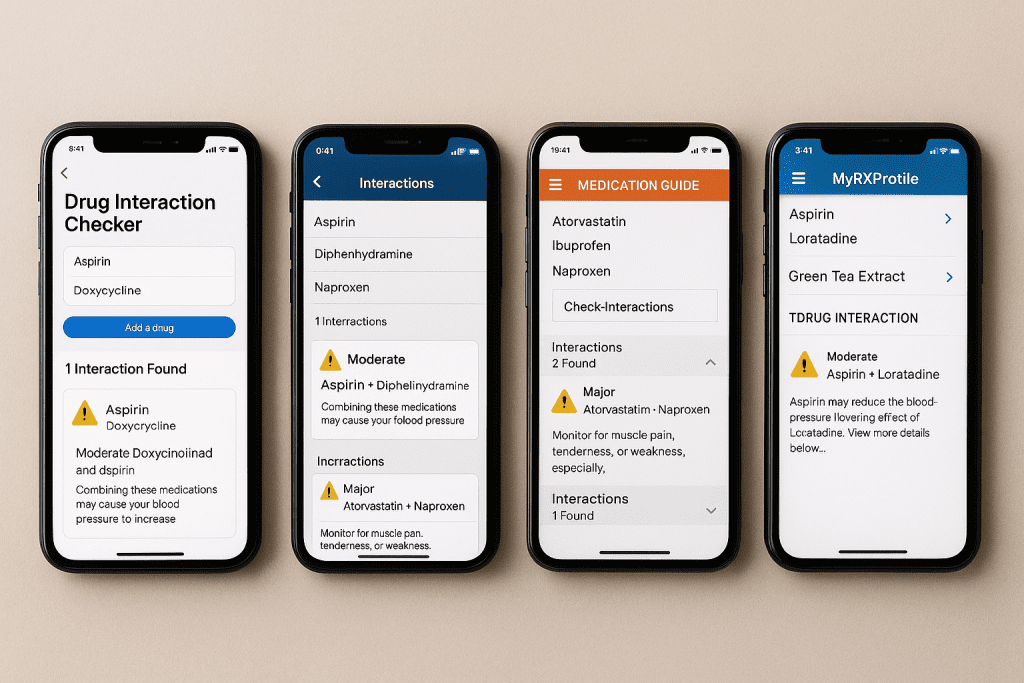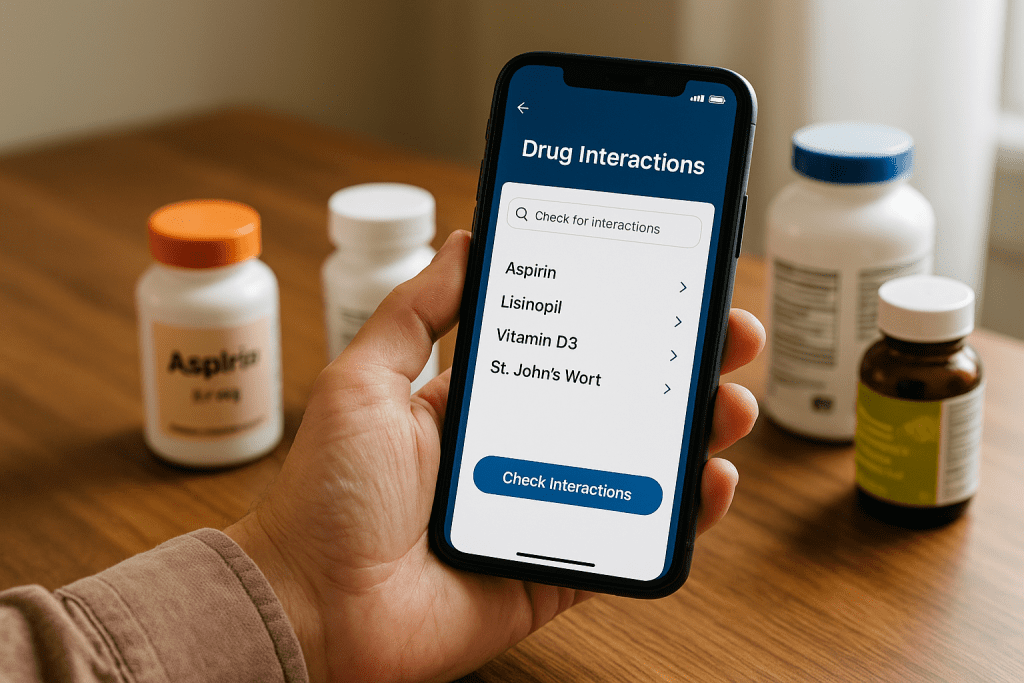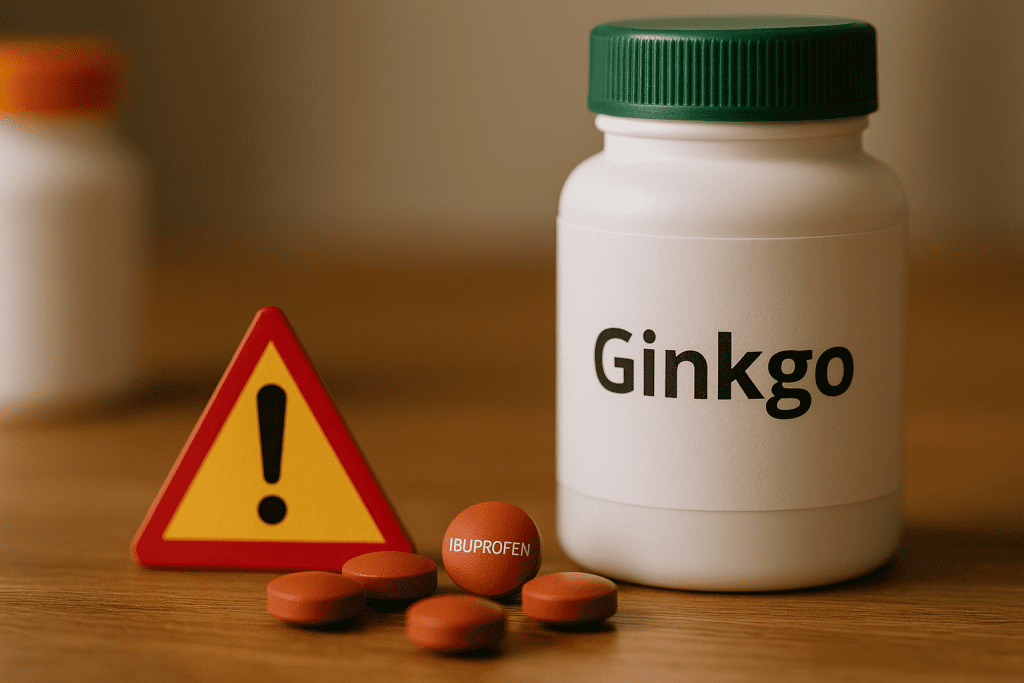Combining supplements with over-the-counter (OTC) medications may seem harmless, but hidden interactions can lead to serious health consequences.
That’s why it’s essential to know how to check OTC drug supplement interactions using reliable and fast tools.
Whether you take fish oil, iron, or herbal products, this article breaks down the safest ways to screen for risks, interpret results, and know when it’s time to talk to a pharmacist or doctor.
Summary / Quick Answer
Want a quick way to check OTC drug supplement interactions? Here are the fastest and most effective options:
- Mobile apps: Epocrates, Pocket Pharmacist, Drugs.com, MyRxProfile
- Web tools: WebMD, Medscape, DrugBank
- Herbal-specific tools: HerbList (NIH-backed)
- Professional checkers: Integrative Therapeutics (for clinicians)
- Best practices: Always document your full regimen, check in multiple tools, and consult your provider if risks appear
These quick interaction checker options help reduce pharmacy OTC caution concerns, offering peace of mind and timely guidance.
Why You Should Always Check OTC Meds and Supplement Combos
Think you’re safe with common OTCs like ibuprofen or antacids? Think again. Many popular supplements can interact with everyday meds in ways that aren’t obvious:
- Calcium can block antibiotics like doxycycline Calcium supplements blocking antibiotic effectiveness
- Potassium raises risk when taken with ACE inhibitors Potassium supplements and ACE inhibitor dangers
- Iron competes with thyroid meds, leading to fatigue Fatigue from iron supplements and thyroid meds
- Licorice root may cause potassium depletion if you’re taking diuretics
Even herbal teas or vegan supplements can complicate treatment. That’s why a reliable, fast interaction checker isn’t just convenient – it can be lifesaving.
| OTC Drug | Risky Supplement Combo | Possible Outcome |
|---|---|---|
| Ibuprofen | Fish oil, garlic, ginkgo | Increased bleeding risk |
| Antacids | Zinc, calcium, magnesium | Reduced absorption of drugs |
| Decongestants | St. John’s wort | Blood pressure spikes |
| Antihistamines | Valerian root, kava | Sedation, dizziness |
The Best Apps for Fast Drug-Supplement Checks

Epocrates and Pocket Pharmacist (Professional Tools)
Over a million clinicians trust Epocrates. It offers:
- Prescription + OTC + supplement checks
- Offline functionality
- Black box warnings and dosing tools
- Real-time updates
Pocket Pharmacist stands out for its plain-language explanations. It offers:
- Interactions + overlapping precautions
- A conversational tone ideal for non-experts
- Works without internet
These are excellent options if you’re managing complex regimens or want clinical-level detail without jargon.
Consumer-Friendly Apps: Drugs.com & MyRxProfile
Both Apple and Android users highly rate Drugs.com Medication Guide. It lets you:
- Scan for drug-drug, drug-food, and drug-supplement issues
- Track alcohol interactions
- Save your medication profile
MyRxProfile enables the scanning of pill bottles and barcodes to detect risky combos quickly. Features include:
- Family member profile support
- Daily medication reminders
- Alerts about ingredient overlaps (great for combination cold meds)
These apps are ideal if you want speed, simplicity, and personalized alerts.
Visual Comparison of Top Mobile Apps
| App Name | Interaction Focus | Offline Access | Best For |
| Epocrates | RX + OTC + supplements | Yes | Clinical-level insights |
| Pocket Pharmacist | Safety + side effects | Yes | Layperson-friendly use |
| Drugs.com | Drugs, food, alcohol | No | Quick scans + saved lists |
| MyRxProfile | Ingredient overlaps | Yes | Barcode scanning + alerts |
Specialized Herbal and Supplement Tools

When you’re using herbal supplements like turmeric, kava, or ginkgo, general apps may not be enough.
HerbList, developed by the National Institutes of Health, focuses entirely on herb-drug interactions. It covers:
- Over 50 popular herbs
- Side effects, safety concerns
- Scientific references for each entry
If you’re taking any traditional or plant-based supplements, HerbList adds a necessary layer of insight.
Integrative Therapeutics also offers a pharmacist-only nutrient interaction tool. While access requires verification, it gives:
- Nutrient and drug interaction insights
- Practitioner education
- Reliable clinical background
This is useful if you’re working with an integrative or functional medicine provider.
Online Platforms for Desktop Users
Prefer to check from your laptop? These web tools offer reliable interaction checking without an app:
WebMD Interaction Checker
- Covers drugs, vitamins, supplements, and food
- Offers plain-language summaries
- Easy to use for all experience levels
Medscape Drug Reference
- Professional-level content
- Real-time updating
- Great for those already managing prescriptions online
DrugBank Interaction Tool
- Allows up to five simultaneous checks
- Labels interactions by severity: minor, moderate, major
- Offers detailed scientific explanations
These platforms offer a good fallback or supplement to mobile apps, especially for people managing long-term treatments.
Understanding the Different Types of Interactions
Checking interactions isn’t just about spotting a red alert. You also need to understand what each flag means.

Here are the main types:
- Drug-drug: OTC + supplement or two OTCs (e.g., ibuprofen + aspirin)
- Drug-food: Supplement taken with incompatible foods (e.g., calcium with coffee)
- Drug-condition: Medication reacting with a health issue (e.g., decongestants and high blood pressure)
Behind many of these risks is the cytochrome P450 enzyme system. Supplements like St. John’s wort can change how your liver breaks down medications, sometimes rendering them ineffective.
How to Safely Use a Quick Interaction Checker
Using a quick checker is only helpful if you use it the right way. Here’s what that looks like:
- List everything – include OTC meds, supplements, herbals, and even teas
- Include dosages and timing – two pills in the morning isn’t enough detail
- Run your list through at least two tools – compare results for consistency
- Check alerts by severity – red usually means avoid, yellow means monitor, green is likely safe
- Look for flags on ingredient overlap – especially in combo products like multivitamins or cold meds
- Consult your pharmacist if anything’s unclear
Pharmacists remain an essential final checkpoint. They understand drug metabolism and can help with substitutions or timing strategies.
Conclusion
Knowing how to check OTC drug supplement interactions can prevent side effects, reduce pharmacy OTC caution, and support safer daily health habits. Use tools like Epocrates or Drugs.com to catch problems early, especially if you’re taking multiple meds or supplements. When in doubt, always consult a professional.
Explore more:

